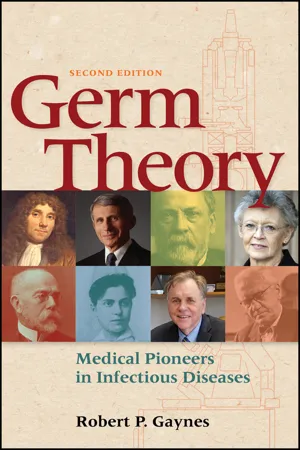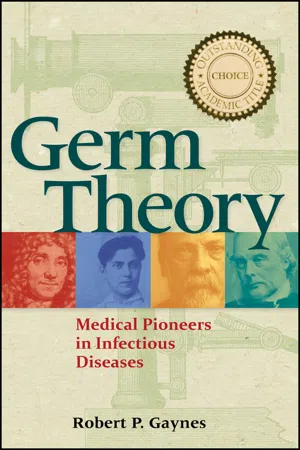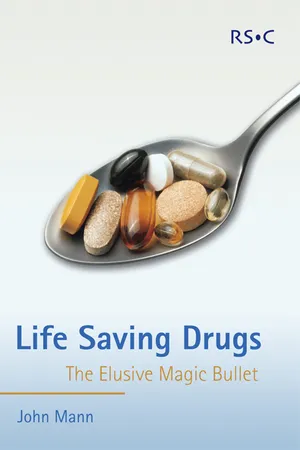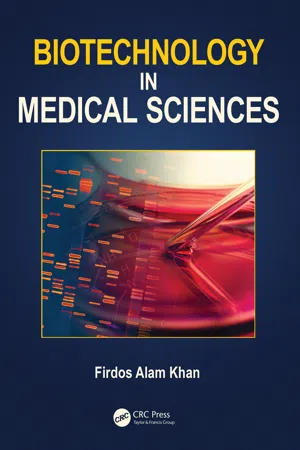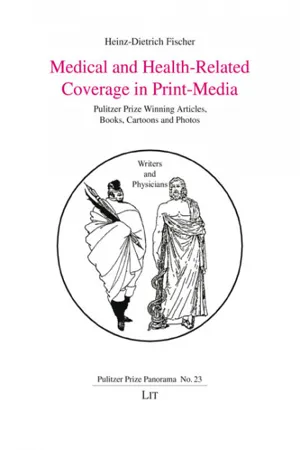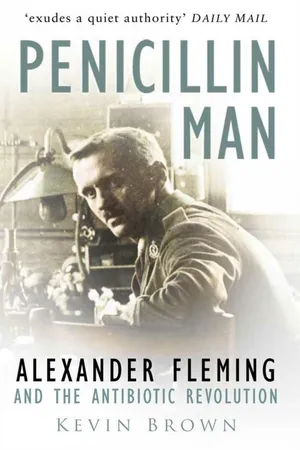Biological Sciences
Alexander Flemming
Alexander Fleming was a Scottish biologist and pharmacologist who is best known for his discovery of the antibiotic substance penicillin in 1928. This breakthrough revolutionized the treatment of bacterial infections and had a profound impact on medicine and public health. Fleming's work laid the foundation for the development of numerous other antibiotics, saving countless lives and shaping the field of microbiology.
Written by Perlego with AI-assistance
Related key terms
1 of 5
6 Key excerpts on "Alexander Flemming"
- eBook - PDF
Germ Theory
Medical Pioneers in Infectious Diseases
- Robert P. Gaynes(Author)
- 2023(Publication Date)
- ASM Press(Publisher)
After the war, he com- pleted his medical studies, receiving his Doctor of Medicine degree in 1921. In 1927, he began working at Bayer Laboratories, a research division of the IG Farben conglomerate in Germany. With the help of chemists, Domagk and his team were testing some 30 chemicals a week for antibacterial activity. THE BEGINNINGS OF THE PENICILLINS Penicillin was discovered entirely by accident rather than by the methodical trial-and- error process that led to Prontosil. At nearly the same time that Prontosil was found, Alexander Fleming stumbled over the antibacterial compound that was produced by another microorganism, a mold. But his 1929 discovery would not find its way into clinical use for a decade. The reason for this delay had much to do with Fleming himself. ALEXANDER FLEMING: EARLY INFLUENCES Alexander Fleming was born on 6 August 1881 in southwest Scotland (2). He was the second youngest of eight children. His father had two daughters and two sons by his first wife, who passed away. He remarried at the age of 60. His second Alexander Fleming and the Discovery of Penicillin • 245 marriage resulted in a son and a daughter before Alec (as he was known) was born. A younger brother was born 2 years later, in 1883. His father had a stroke and died when Alec was only 7 years old. Fleming’s extended family was largely respon- sible for raising the boy. He attended school on the moors until 1893, when he went to Kilmarnock Academy, the alma mater of Robert Louis Stevenson and Robert Burns. At the age of 13, Alec moved to London. He was enrolled in Regent Street Polytechnic, where he did quite well in school. When Alec was 16, he took an apprenticeship with a shipping firm. Following the tradition of the males in his family, when Alec turned 18, he joined the London Scottish Rifle Volunteers. His short stature (he was 5 ft 6 in. tall) led to much teasing. - eBook - PDF
Germ Theory
Medical Pioneers in Infectious Diseases
- Robert P. Gaynes(Author)
- 2020(Publication Date)
- ASM Press(Publisher)
With the help of chemists, Domagk and his team were testing some 30 chemicals a week for antibacterial activity. The Beginnings of the Penicillins Penicillin was discovered entirely by accident rather than by the me- thodical trial and error process leading to Prontosil. At nearly the same time that Prontosil was found, Alexander Fleming stumbled Alexander Fleming and the Discovery of Penicillin 267 over the antibacterial compound that was produced by another mi- croorganism, a mold. But his 1929 discovery would not find its way into clinical use for a decade. The reason for this delay had much to do with Fleming himself. Alexander Fleming: Early Influences Alexander Fleming was born on 6 August 1881 in southwest Scot- land (14). He was the second youngest of eight children. His father had two daughters and two sons by his first wife, who passed away. He remarried at the age of 60. His second marriage resulted in a son and a daughter before Alec (as he was known) was born. A younger brother was born 2 years later, in 1883. His father had a stroke and died when Alec was only 7 years old. Fleming’s extended family was largely responsible for raising the boy. He attended school on the moors until 1893, when he went to Kilmarnock Academy, the alma mater of Robert Louis Stevenson and Robert Burns. At the age of 13, Alec moved to London. He was enrolled in Regent Street Polytech- nic, where he did quite well in school. When Alec was 16, he took an apprenticeship with a shipping firm. Following the tradition of the males in his family, when Alec turned 18, he joined the London Scottish Rifle Volunteers. His short stature (he was 5 ft 6 in. tall) led to much teasing. Fleming did not have a prodigious career with the Volunteers, although he was an expert shot with a rifle. After 4 years out of school, Alec passed an examination that qualified him for en- trance into medical school. - eBook - PDF
Life Saving Drugs
The Elusive Magic Bullet
- John Mann(Author)
- 2007(Publication Date)
- Royal Society of Chemistry(Publisher)
The fortunate outcome of what had been a dangerous experiment obvi-ously made a huge impression on Fleming, because he immediately con-tacted friends in the government and a Penicillin Committee was soon established. The pharmaceutical industry was finally galavanised into action, and pencillin production began in earnest. As stories began to emerge about the efficacy of penicillin, the press printed stories about this new ‘miracle cure’, and about its inventors. Much of the mythology about Fleming arises out of misinformation printed at this time. More seriously, a certain degree of ill-feeling between the London and Oxford groups arose from ill-conceived comments about the relative importance of their respective discoveries. Several letters to the Times make interesting read-ing. Sir Almoth Wright, Professor of Bacteriology at St. Mary’s Paddington when Fleming was making his seminal discovery, wrote on August 31, 1942 suggesting that Fleming should receive the laurel wreath “for he is the discov-erer of penicillin and was the author of the original suggestion that this sub-stance might prove to have important applications in medicine”. Sir Robert Robinson responded on September 1 that “a bouquet at least, and a handsome one, should be presented to Professor Florey”. This was all rather unfortunate and the controversy was resolved in 1945 when the Nobel Prize for Physiology or Medicine was awarded jointly to Fleming, Florey and Chain, a fitting reward for what had been one of the outstanding achievments of the 20th century. SEMI-SYNTHETIC PENICILLINS AND THE GROWING PROBLEM OF RESISTANCE The chemical structure of the penicillins remained in doubt throughout the war years despite considerable efforts and much speculation by a group led by Karl Folkers at Merck, and the Oxford group comprising Robert Robinson, Chain, Abraham and others. - eBook - PDF
- Firdos Alam Khan(Author)
- 2014(Publication Date)
- CRC Press(Publisher)
Penicillin was discovered by Scottish scientist and Nobel laure-ate Sir Alexander Fleming in 1928. It all started with a basic experiment where Sir Fleming noticed a Petri dish containing Staphylococcus plate culture which he had mistakenly left open was contaminated by blue-green mold, which had formed a visible growth. But sur-prisingly he also found that there was a circle of inhibited bacterial growth around the mold. Later on, Sir Fleming hypothesized that the mold was releasing a substance that was preventing the growth and could contain a substance with antibiotic properties. In order to prove his hypothesis, he grew a pure culture and discovered the first antibiotic substance from the Penicillium mold, known as Penicillium notatum . Sir Alexander showed that P. notatum when grown in the appropriate substrate caused the release of chemical substances and these chemical substances were named as antibiotics. He later on named CH 2 O C CH 2 NH 2 H Penicillin G Penicillin V Ampicillin NH O CH 3 CH 3 N S H H R O H COOH R = Figure 1.3 Structures of penicillin G, penicillin V, and ampicillin. 4 Biotechnology in medical sciences that chemical substance as penicillin. Soon after this discovery, penicillin was considered to be the most effective drug against bacteria (Gram-positive bacteria), and not at all effec-tive against Gram-negative bacteria. The discovery of penicillin marks the beginning of the antibiotic production and so far more than 200 different types of antibiotics have been produced (Figure 1.3). 1.3.2 Recombinant insulin Another discovery which was made in the medical field was the recombinant DNA tech-nology, which has completely revolutionized disease treatments especially in the Type 1 diabetes mellitus, where insulin-producing cells become dysfunctional and do not produce sufficient amount of insulin to regulate blood-sugar level. In a healthy human being, insu-lin regulates glucose metabolism in the body. - Heinz-Dietrich Fischer(Author)
- 2020(Publication Date)
- LIT Verlag(Publisher)
He proved it was nontoxic to rabbits and mice by injecting it into their ear veins and abdominal cavities. He used it as a surface dressing in several cases of infected wounds and reported that they seemed to clean up rapidly. He made, in 1929, the specific prediction that penicillin may prove to be an efficient antiseptic when injected into areas infected with penicillin-sensitive organisms. And at this point he stopped. He had demonstrated an apparently nontoxic substance which was effective against certain dangerous bacteria when grown in laboratory media. The problems which remained were the chemical one of producing penicillin in quantity and the clinical one of determining its effectiveness. These problems remained unsolved for ten years and even unattacked, save that, at the London School of Hygiene in I932, Raistrick grew the mold and attempted to extract penicillin from the culture media. He was dissuaded from continuing his experiments, as so many were very nearly dissuaded later, by the chemical difficulties involved in isolating such an unstable substance. 158 As Fleming had been the chief character in the first act of the penicillin drama so Sir Howard Florey, an Australian-born Professor of Pathology at Oxford, and his colleague, Ernest Chain, became chief characters in the second act - a sort of revival staged in I939. The philosophical implication of Fleming’s work was clear. The war between the species which we see going on all about us in the world, too closely about us, extended beyond our vision into the microscopic world. A mold dropped from the air onto a bacterial village, a colony, and its inhabitants were promptly liquidated. A very neat parallel. The demonstration was not entirely a new one. In Pasteur’s laboratory the destruc- tive effect of certain airborne bacteria upon the bacillus of anthrax had been observed.- eBook - ePub
Penicillin Man
Alexander Fleming and the Antibiotic Revolution
- Kevin Brown(Author)
- 2005(Publication Date)
- The History Press(Publisher)
EIGHT Challenge for AmericaT he end of the Second World War found Fleming back in the United States from which he had made a mad dash home to London at the outbreak of war six years previously. Then he had been one of a number of delegates at a microbiological congress. Now, his second visit to North America took on more of the character of a triumphal tour, as the modest Scot whose discovery had seemingly vanquished infection was greeted everywhere with all the honour more usually given to a victorious general touring the battlefields on which his reputation had been won. Universally he was greeted as the man who had given the world penicillin, though he had been warned in advance not to expect such treatment: ‘I had been told in many quarters it was believed that penicillin originated in America but that I cannot accept, as everywhere in the public press as well as in scientific quarters, I have received my full share of credit for the initiation of the work.’1 For Fleming it was the opportunity to see for himself the great advances that had been made in North America to enable mass production of penicillin to become a reality.What struck Fleming most from his triumphant American tour was that ‘It is evident that they think more of penicillin in America than in England’.2 Everywhere he went in the summer of 1945 he was lionised during a series of press conferences, radio interviews and public lectures orchestrated for him by John Cameron, his minder from the British Mission, who confessed that he had fallen ‘completely under his spell’.3 His American tour was a success from the moment he set sail on the Aquitania and gave a lecture on the discovery of penicillin to his fellow travellers in mid-voyage. Despite his dislike of such lecturing, he was coming to tailor what he said to his audience, increasingly non-medical. He also joined his shipmates in conversation though was perhaps a better listener than talker.4
Index pages curate the most relevant extracts from our library of academic textbooks. They’ve been created using an in-house natural language model (NLM), each adding context and meaning to key research topics.
